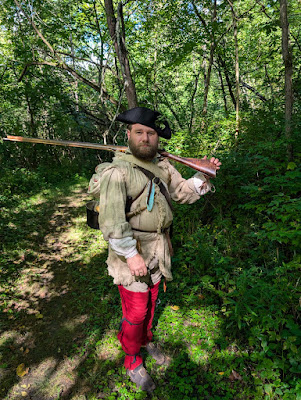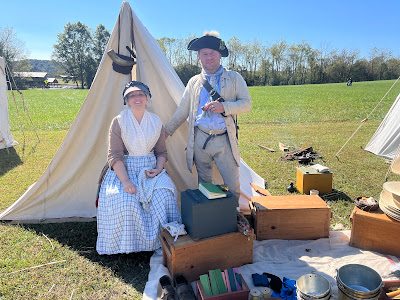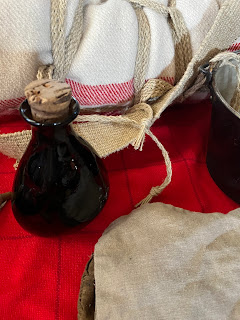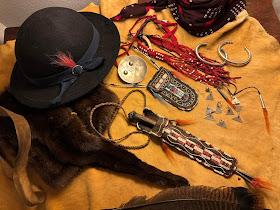Well, preparations for the 250th of Dunmore's War at Prickett's continue. I've been trying to get out in kit and hike and make adjustments. Everything is riding good and the pocket bottle is working great. Thanks Kobuck. Actually I like it in some ways better than the canteen. The canteen always rides at the back and underneath my bedroll strap or tucked behind my knapsack and so accessing it with all the gear over top can be a challenge. Whereas the pocket bottle, riding in the front side of the wallet was easily accessed while on the move. It's these little things that really make a world of difference.
As I hiked yesterday, I thought about the word "impression." A funny word to describe putting together an outfit from 250 years ago. It has several definitions depending on how you use it, but the one that suits our purposes goes something like "a graphic or pictorial representation of someone or something." These impressions of ours are supposed to be a window into the past, an illusion that we are indeed militiamen from 1774 or a British soldier, a trader, a longhunter etc. but in reality we are modern men and women working modern jobs in modern society. We try to offset our modernness by going into the woods and trying our hand at some of the skills our forbearers possessed.
For the public though, this first "impression" can really shape what they think about our nation's past. It can either perpetuate a stereotype, bolster old myths, or it can make one rethink and form new opinions on what exactly our ancestors looked like while reading the pages of Allen Eckart or thumbing through a Nathaniel Philbrick journalistic account. We become the first and maybe last impression for folks as they wind their way through an event stopping at sutlers and seeing the soldier camps.
I've been watching a lot of old movies, which I love. Those old movies sparked the fire for a lot of kids in my dad's generation and the generation before to really dive into history. As cheesy and hokey as some of them could be, it was the impression that really inspired a generation of young people to get excited about history and eventually to build their own impression of just what it might have looked like. From the early adaptation of Last of the Mohicans to Drums Along the Mohawk, Northwest Passage and Unconquered, history was portrayed in very black and white terms. America, its principles, its founders were mythic ideals and heroes who were above reproach. The white man's triumph over the harsh wilderness, the manifest destiny and the taming of the North American continent. Then along came Walt Disney's Davy Crocket, King of the Wild Frontier that leaned heavily into the rugged individual who stands up for what is right and who lends a hand when the going is tough. All good qualities to be sure. But, what of the reality? We'll get to that. This generation raised on Davy Crockett, Daniel Boone on TV (both played by Fess Parker) along with Johnny Tremain, the Light in the Forest etc. grew up to be the first and second waves of what we know as reenactors. Of course Civil War was happening, and the BAR had started, but this group began doing blackpowder shoots, got really into the western fur trade, marched in local bicentennial parades with their unit or muzzleloading club. And in those days, it had a sort of "Mayberry Founders Day Pageant" quality to it all. An impression, albeit an incomplete one.
The Bicentennial era really propelled things along though. Out came Sketchbook 76 and the Encyclopedia of the American Revolution, books that would really become the gold standard of the time. And so, black powder shooting began to have another element-the gear that our ancestors wore and carried. Reproductions are being produced and the next layer of the impression starts to be examined. It's not just about shooting a gun anymore, but what did they have on their person. The 20th century saw the rise of the "primitive skills" movement. People who were already involved in that movement easily gravitated towards this new hobby where they could combine skills and their love of history. People started organizing treks and hunting camps sometimes called a "pack in" where one could put the skills, gear and gun knowledge to the test. Magazines like Muzzleloader became a companion piece to these journeys in history, and it was in the pages of Muzzleloader where I believe the next layer of the impression comes along.
 |
| Pack in organized by David Book in Iowa, 1979 |

Mark Baker. His name has become synonymous in our hobby with walnut dyed smocks and hunting shirts worn by "long hunters." His impact can't be overstated in my opinion. Mark was a schoolteacher by trade and his writing style was polished but with a charming down home style that really brought a homespun yarn to life. He took his readers along on his adventures into the woods and really showed a whole new group of people what was possible and how history could be accessed in a very hands on way. A term that was eventually coined was "historical trekking" and so the Trekker era began. It exists as its own thing in the broader world of reenacting. Remember, groups like the BAR, NWTA etc were doing historical reenacting, but this was confined to a weekend at a public site, talking with tourists who came to see the sutlers and the two o'clock battle. Mark was doing this stuff without an audience aside from the readers who hung on his every word and who took this new impression and ran with it. Suddenly it was "the look." Everybody was dying smocks with walnuts and rolling their top shirt sleeve up over their undershirt sleeve. The Coalition of Historical Trekkers was formed and its members were regulars at Caesars Creek, Manskers Station, Martins Station and Bledsoe's.
During this phase, the Internet became a thing and suddenly information that was only available through the library or by visiting a museum or an archive was suddenly available to the masses. In some cases brand new information surfaced for the first time, and in other cases, information was reexamined and new conclusions were made based on more adjacent sources being cross referenced and more eyes being put on the source material. The forum wars raged on how far to push "authenticity." Sites like Ticonderoga threw out the old playbook of annual encampments centered around the two O'clock battle in favor of a more immersive and intimate view into the daily life and times of those who lived in and around Ticonderoga from the days of the French and Indian War to Ethan Allen and the Green Mountain Boys. This caused a large swath of people to feel alienated and hurt by the tightening of the standards. In contrast, sites like Vincennes continue the founders day pageant model that more resembles a pre-1840s renaissance faire than the market fairs of Locust Grove and Manskers Station of old. People like Nathan Kobuck began writing blogs and trying to push for a more detailed look into the long hunter trade of the 1760s. Others pushed back, clinging to the notion of the rugged individual trekking through the woods on foot with a knapsack and a Wilde blanket.
As we are coming into the post pandemic years, I feel we are in the next phase and that brings me to the phrase that I hear often, "the hobby is dying." This comment is usually made by the generation that proceeded us or people who attend run of the mill, two o'clock battle events. I understand why that is the feeling, but I have a different view. I think the hobby is in great shape, it's just changing. Younger people just aren't as enamored with the old format. They want to build on the Mark Baker format, hitting the woods, using the gear, doing events that are immersive or one offs where a specific impression is built and you do that, unlike the old days where your impression was your impression and you chose your events based on that. Now the idea is to pick the event and then build the impression. Not just some generic thing, but really researching and putting together something that fits the needs of the event. Much like what we are doing for Pricketts. It's the culmination of all of the little niches with in the hobby coming together and creating an impression that is more well thought out, that relies on the work of our forbearers and pushes us to new and better heights. An impression that will give future generations a better idea of the nuances and details and will flesh out the silhouettes and caricatures of bygone films and movies that inspired that first generation to take up a muzzleloader and throw on a coonskin cap and figure it out. Honoring their legacy is important and moving forward doesn't take away what they did, it enhances it and makes it all the more important.
The Impression I get is that young people are very hungry for history, and the Impression that we do could either be a turnoff, or a turn on. Authenticity is attractive, so let's attract the next generation and give them the best impression we can.















































